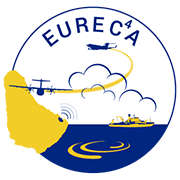1 Feb
Today we have a text-book trade wind sounding (Fig1). Look at the sharpness of the temperature inversion at 3 km and the strength of the hydrolapse where water vapor mixing ratios fall be more than an order of magnitude. The sounding was at 12 Z or 8am local time. It also seems to show to stratiform cloud layers (humidity peaks) one at 720 hPa, the other near 800 hPa. If you look in the radar data for the period both of these are evident, and they are also evident in the lidar backscatter (Fig 2), comparing for instance 6 and 10 Z.
I also show the Meteosat (visible, Fig3 and IR-CloudTop, Fig4) from Akio’s archive for 1400Z which shows the cloud presentation with a very well defined cloud top. Remember Barbados is near the 60W 15 N point (acutally 59W, 13N). Looking a bit further afield the ITCZ is well defined as a broad line in the convection, stretching ENE from about 2degN and 40 W to 10 degN and 10W. But what I find most interesting, and what I have become accustomed to seeing is that across the broad ITCZ, which has a width of about 5deg of latitude, there are two thinner and parallel lines of convection, in the west it is obscured by high clouds in places, but this ITCZ eyewall is evident across the whole atlantic.
The sounding tells us that orange color in the cloud-top product corresponds to 3 km, and that the cellular structure in the tades is better defined by the clear area than it is by the clouds. Finally I show the water vapor from the Raman (there seems to be a calibration issue below 500 m), but the definition of this gradient and the complete absence of scatterers in the free troposphere puts us in trade-wind heaven.





